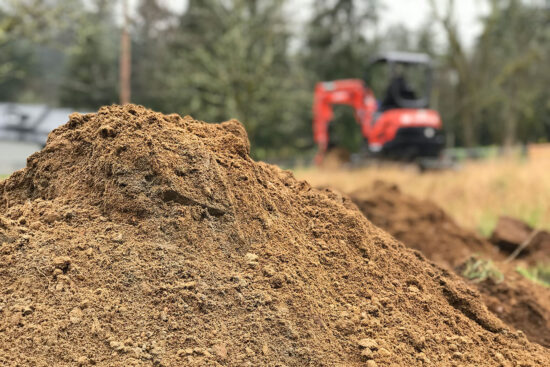- 253-509-9922
- 5711 34th Ave, Gig Harbor, WA 98335
Design
Quality Services & Specialists
DESIGNing your septic system
How we determine what type of system can be designed for your property
Septic systems are designed primarily by depth of native, undisturbed soil to a restrictive layer. A restrictive layer is anything that can impeded the flow of sewage through the soil such as glacial till (also called hard pan), a water table, clay, or other impervious soil feature. The beneath the sewage disposal trench and above a restrictive layer is called vertical separation. The amount of vertical separation in the soil is primarily what determines the type of septic system that can be designed for your property. Other factors can influence the type of system that can be designed, such as reduced proximity to surface water, cut banks, building foundations, property lines, etc.
Reducing septic system setbacks to surface water, cut banks, etc. will usually require an increase in treatment of the sewage before it’s disposed of in the soil.


Gravity
We’re always happy when we can design a gravity system for our clients. Gravity is the simplest and least expensive type of septic system that can be designed for your property, and consists of a 2-compartment septic tank, transport line, a distribution box, and gravity flow disposal trenches (drainfield). 3 feet of vertical separation is required for gravity systems.
Pressure Distribution
If there isn’t enough depth of soil for a gravity system, pressure distribution is the next best thing. A pressure distribution utilizes the the entire infiltrative surface area of the drainfield with each timed dose of sewage. In addition to a septic tank, this is accomplished with an effluent pump in a dedicated pump tank, a pump timer and control panel, forcemain, header manifold, and pressurized distribution pipe in each of the drainfield trenches. Pressure distribution requires at least 2 feet of vertical separation.
Alternative Systems
Alternative-type septic systems are required when the soil is shallow, very fine textured, or a reduced setback to surface water, cut banks, building foundations, property lines, etc. are required. Alternative septic systems provide an increased treatment to the sewage before it is discharged to the soil, to reduce the biological load that the soil is required to handle. The increased treatment can be accomplished by an Aerobic Treatment Unit (ATU) that pumps air into the tank to increase the presence of more efficient aerobic bacteria, or with passive treatment such as sand-lined trenches or sand mounds, or a combination of both. Alternative treatment systems require a minimum of 12 inches of vertical separation. If the soil depth is less than 18 inches, an above-ground, or mound system is required.
© Copyrights are Reserved by Apex Septic Design, LLC 2023

